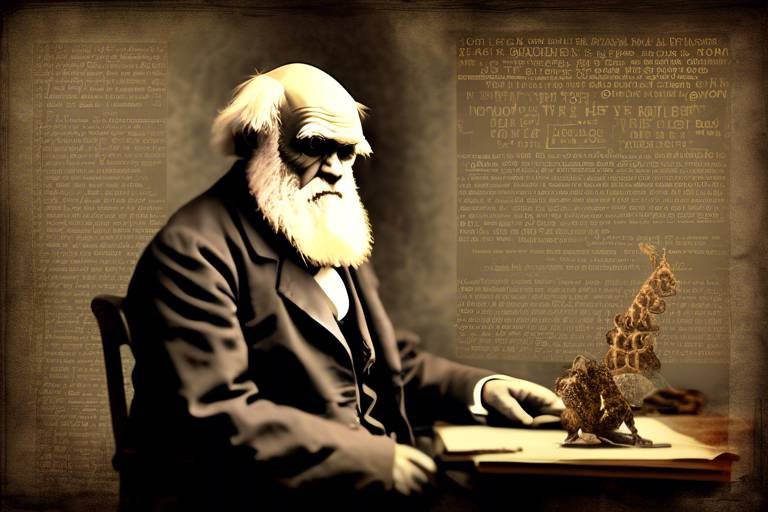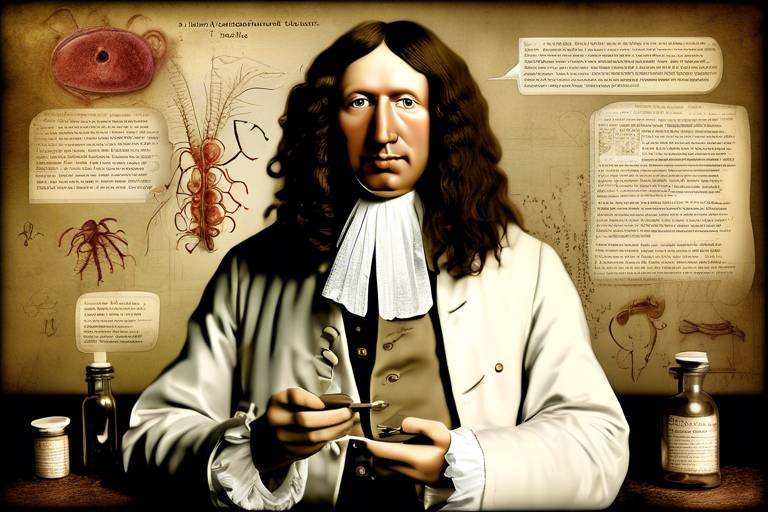The Discoveries of Alfred Wegener in Plate Tectonics
Alfred Wegener, a name that resonates through the corridors of geological history, is best known for his revolutionary ideas about plate tectonics. His theories not only changed the way scientists viewed the Earth but also bridged gaps between various scientific disciplines. Imagine standing on a vast, unyielding land, only to realize that beneath your feet, the very ground is shifting—this was the essence of Wegener's vision. He proposed that the continents were not static, but rather, they were once part of a colossal landmass that drifted apart over millions of years. This radical idea, known as the continental drift theory, opened a Pandora's box of questions and research, reshaping our understanding of geological processes.
Wegener's journey into the realm of plate tectonics was not a solitary one. He was a keen observer, meticulously gathering evidence from various fields such as paleontology, climatology, and geology. His work laid the groundwork for what we now understand as plate tectonics, a theory that explains the movement of Earth's lithospheric plates and how they interact with one another. The implications of his findings are monumental, influencing everything from our understanding of earthquakes to volcanic activity and mountain formation. In essence, Wegener's discoveries ignited a scientific revolution that continues to evolve today.
As we delve deeper into Wegener's contributions, we find that his theories were not merely speculative; they were backed by a plethora of evidence that still holds weight in modern geology. From fossil records to geological formations, Wegener's observations painted a compelling picture of a dynamic Earth, constantly reshaping itself over time. His ideas may have faced skepticism during his lifetime, but they ultimately paved the way for a more profound understanding of our planet's geological history.
In the following sections, we will explore Wegener's theories in detail, examining the evidence he presented, the criticisms he faced, and the lasting impact of his work on contemporary geology. Buckle up as we journey through the fascinating world of plate tectonics, guided by the insights of one of its pioneering figures!

Continental Drift Theory
Alfred Wegener's was a revolutionary concept that suggested the continents were not static entities, but rather dynamic landmasses that had once been joined together in a single supercontinent known as Pangaea. Imagine a giant jigsaw puzzle, where all the pieces once fit snugly together, only to be pulled apart over millions of years. This idea completely reshaped our understanding of Earth's geological history, challenging the long-held belief that continents were fixed in their positions.
Wegener proposed that the continents had drifted apart due to the movement of tectonic plates, a concept that was radical for its time. His theory was based on a variety of observations, including the fit of the continents, the distribution of fossils, and geological formations. For instance, if you look closely at the coastlines of South America and Africa, they seem to align perfectly, almost like two halves of a broken cookie. This visual evidence was one of the key points that prompted Wegener to theorize about a unified landmass.
In his groundbreaking work, Wegener argued that the continents were once part of a larger landmass that began to break apart about 200 million years ago. He suggested that this process of drifting continues today, albeit at a very slow pace. To put it into perspective, continents shift at an average rate of about 2 to 5 centimeters per year, which is roughly the same speed at which your fingernails grow!
Wegener's theory was not without its criticisms. Many scientists of the time were skeptical, primarily because Wegener could not provide a mechanism to explain how the continents moved. It was like presenting a beautiful painting without revealing the artist's techniques. However, as more evidence emerged over the years, including advancements in our understanding of plate tectonics, Wegener's ideas gained acceptance. His theory laid the groundwork for modern geology and opened the door for further research into the movement of tectonic plates.
In summary, Wegener's continental drift theory was a pivotal moment in geological science. It challenged the status quo and encouraged a new way of thinking about the Earth's surface. As we continue to explore the complexities of our planet, Wegener's insights remind us that the Earth is a living, breathing entity, constantly changing and evolving.
- What is continental drift? Continental drift is the theory that continents have moved over geological time from one location to another.
- Who proposed the theory of continental drift? The theory was proposed by Alfred Wegener in the early 20th century.
- What evidence supports the theory? Evidence includes the fit of continental coastlines, fossil records, geological similarities, and ancient climate indicators.
- Why was Wegener's theory initially rejected? Many scientists were skeptical due to the lack of a mechanism to explain how continents could move.
- How has the theory of continental drift influenced modern geology? It laid the foundation for the development of plate tectonics, which is essential for understanding earthquakes, volcanic activity, and mountain formation.

Evidence from Fossils
Alfred Wegener's revolutionary ideas about continental drift were bolstered by compelling evidence from fossils. Imagine discovering a treasure map that leads you to the same spot on different islands; that's essentially what Wegener did when he examined the fossil records across continents. He found that certain species, which thrived millions of years ago, were remarkably similar or even identical, yet they were located on continents that are now separated by vast oceans. This striking resemblance suggested that these continents were once part of a larger landmass, offering a window into a time when they were joined together.
One of the most notable examples was the fossil of the Mesosaurus, a freshwater reptile. This creature was found in both South America and Africa, and its presence in such distant locations raised eyebrows among scientists. The only plausible explanation for this phenomenon was that these two continents were once connected, allowing the Mesosaurus to inhabit a continuous body of water. Without a land bridge, how could this reptile have crossed the ocean? The answer was clear: it couldn’t. This evidence was a significant piece of the puzzle that Wegener was trying to solve.
Wegener didn't stop there; he also examined the fossils of plants and other animals. For instance, fossils of the ancient plant Glossopteris were found in regions ranging from South America to Antarctica. This plant thrived in a warm climate, yet its fossils were located in areas that are now icy and inhospitable. How could such a plant have existed in these diverse climates unless the continents were once clustered together in a more temperate zone? This kind of evidence was crucial in piecing together the past geography of our planet.
In addition to the Mesosaurus and Glossopteris, Wegener's research revealed a plethora of other fossil finds that supported his theory of continental drift. These discoveries included:
- Cygnognathus: A therapsid found in both Africa and South America.
- Lystrosaurus: A land reptile discovered in Africa, India, and Antarctica.
- Fossilized trees: Found in areas that are now polar regions, indicating they once thrived in a warmer climate.
Each of these fossil discoveries painted a vivid picture of a world that was once interconnected, allowing species to migrate freely. Wegener’s fossil evidence was so compelling that it demanded attention, even from those who were skeptical of his theories. As more fossils were uncovered, the idea of continental drift began to gain traction, ultimately leading to the acceptance of plate tectonics.
In conclusion, the fossil evidence that Wegener presented was not just a collection of ancient relics; it was a compelling narrative that told the story of Earth's dynamic history. His findings provided a strong argument for the existence of a supercontinent, which he named Pangaea, and laid the groundwork for future geological research. Fossils, in this context, became the keys to unlocking the mysteries of our planet's past, demonstrating that the history of life on Earth is deeply intertwined with the movement of its continents.

Mesosaurus Findings
One of the most fascinating pieces of evidence that Alfred Wegener presented in support of his continental drift theory was the discovery of the Mesosaurus, a freshwater reptile that swam the ancient waters of the Earth. This remarkable creature was found in both South America and Africa, raising eyebrows and questions among scientists of Wegener's time. How could a species thrive in two vastly separated continents, unless they were once part of a single landmass? This question was pivotal in pushing the boundaries of geological understanding during the early 20th century.
The presence of Mesosaurus fossils in these two distant locations suggested a few compelling scenarios:
- Continental Connection: The most straightforward explanation was that South America and Africa were once joined, allowing Mesosaurus to inhabit a continuous body of water.
- Species Adaptation: It was unlikely that Mesosaurus could have crossed the vast Atlantic Ocean, given its freshwater nature. This led to the conclusion that the continents must have drifted apart after the species had already evolved.
- Implications for Evolution: The findings also hinted at how species could evolve and adapt in isolation, further enriching our understanding of evolutionary biology.
Wegener's findings on Mesosaurus were not just a single piece of evidence; they were a crucial element in a larger puzzle. By combining this discovery with other fossil records, he painted a picture of a once-unified supercontinent, which he famously named Pangaea. This concept sparked a revolution in geological thought, challenging the long-held belief that continents were static entities. Instead, Wegener's work suggested that the Earth's surface is dynamic and constantly changing, much like a living organism that evolves over time.
Despite initial skepticism, the Mesosaurus findings became a cornerstone of Wegener's argument for continental drift. As more fossil evidence emerged from various parts of the world, it became increasingly difficult for scientists to ignore the implications of these discoveries. The Mesosaurus not only provided a tangible link between continents but also served as a powerful reminder of how interconnected life on Earth can be, even across vast distances.
The Mesosaurus findings were more than just fossil discoveries; they were a catalyst for a paradigm shift in geology. Wegener's ability to connect the dots between these ancient species and the movement of continents has profoundly influenced modern geology. Today, we continue to explore the complexities of plate tectonics, but it all began with the simple yet profound realization that the Earth’s landmasses are not fixed but are in constant motion.
1. What is Mesosaurus?
Mesosaurus was a freshwater reptile that lived during the early Permian period. Its fossils have been discovered in both South America and Africa.
2. Why is Mesosaurus important for the theory of continental drift?
The presence of Mesosaurus fossils in two separate continents provides strong evidence that these continents were once connected, supporting Wegener's theory of continental drift.
3. What was Wegener's theory of continental drift?
Wegener proposed that continents were once part of a supercontinent called Pangaea and have since drifted apart due to tectonic forces.
4. How did the scientific community react to Wegener's theories?
Initially, Wegener faced skepticism and criticism, but over time, as more evidence accumulated, his ideas gained acceptance and laid the groundwork for modern geology.

Geological Similarities
One of the most striking aspects of Alfred Wegener's theory of continental drift is the observed across continents. Imagine standing on the eastern coast of South America and looking across the Atlantic Ocean to Africa. What if I told you that the rocks beneath your feet share a history with those on the other side? This idea was revolutionary in Wegener's time, but it became a cornerstone of his argument for a once-unified supercontinent, which he named Pangaea.
Wegener meticulously analyzed geological formations, mountain ranges, and even the types of rocks found on different continents. He noted that certain mountain ranges, such as the Appalachians in North America and the Caledonian mountains in Scotland, are remarkably similar in composition and age. This similarity suggests that these landforms were once part of the same geological structure before drifting apart. It’s akin to two puzzle pieces that fit perfectly together; when you look at them side by side, their edges align, revealing a shared origin.
To illustrate his point further, Wegener compiled a table showcasing some of the most notable geological matches across continents:
| Geological Feature | Location 1 | Location 2 |
|---|---|---|
| Appalachian Mountains | North America | Scotland |
| Brazilian Shield | South America | West African Shield |
| Antarctic Mountains | Antarctica | Southern Andes |
In addition to mountain ranges, Wegener observed that the types of rocks and their formations were strikingly similar across distant continents. For instance, the sandstone and limestone deposits found in both South America and Africa indicated a shared geological history. This was not merely coincidence; it was evidence of the massive forces that had shaped the Earth's crust over millions of years.
Moreover, Wegener's analysis extended to ancient glacial deposits. The presence of glacial till in regions that are now tropical, such as parts of Africa and South America, revealed a past climate that was vastly different. This evidence pointed to a time when these continents were positioned closer to the poles, further supporting the idea that they were once part of a larger landmass. It’s like finding a winter coat in a warm climate; it suggests that things were not always as they are today.
In conclusion, Wegener's observations of geological similarities across continents provided compelling evidence for the theory of continental drift. His ability to connect the dots between disparate landmasses reshaped our understanding of Earth’s geological history and laid the groundwork for the eventual acceptance of plate tectonics. Today, we can appreciate how these geological connections continue to influence our planet's landscape and the natural phenomena we observe.

Climate Evidence
Alfred Wegener's insights into ancient climates provided a fascinating glimpse into how the Earth's continents have shifted over millions of years. He meticulously analyzed various climate indicators, which revealed that continents we now consider to be in tropical or temperate zones were once situated in drastically different climates. For instance, Wegener pointed out the presence of glacial deposits in regions that are currently warm and tropical, like parts of South America and Africa. This contradiction raised eyebrows and prompted questions about how these continents could have supported such contrasting climates.
Wegener's examination of paleoclimatic evidence was not just a casual observation; it was a well-researched aspect of his theory. He argued that the distribution of certain geological features, such as coal deposits and glacial striations, could only be explained if the continents were once connected. For example, coal deposits found in places like North America and Europe suggest that these regions were once lush, swampy environments, teeming with vegetation. This is a stark contrast to their current climates, which are much cooler and less hospitable to such lush growth.
To illustrate his points, Wegener created a map that showcased the former positions of the continents, highlighting how their movements could account for the current climatic conditions observed today. This map was not merely a visual aid; it was a powerful tool that demonstrated the dynamic nature of our planet. It showed how the continents have drifted apart, taking their unique climates with them, which in turn affects everything from biodiversity to weather patterns.
Furthermore, Wegener’s theory suggested that as continents moved, they would also experience changes in climate. For instance, a continent drifting towards the equator would likely become warmer and more tropical, while one moving towards the poles would become colder and more arid. This concept of climate change due to continental drift was revolutionary, as it linked geological movements to environmental changes, a connection that is still relevant in today’s discussions about climate change.
In essence, Wegener's climate evidence was not just about proving that continents drift; it was about reshaping our understanding of how interconnected geological and climatic processes are. His findings paved the way for future research, prompting scientists to further investigate the intricate relationship between Earth's physical features and its climate systems.

Criticism and Acceptance
When Alfred Wegener first introduced his revolutionary theory of continental drift, he was met with a wave of skepticism from the scientific community. Many geologists of his time found it difficult to accept the idea that continents could drift across the Earth’s surface. After all, the prevailing belief was that the continents were static, firmly anchored in place. Wegener's ideas seemed almost outlandish, akin to suggesting that a giant had picked up the continents and tossed them around like marbles.
One of the major criticisms revolved around Wegener’s inability to provide a convincing mechanism for how continental drift could occur. He proposed that the continents plowed through the oceanic crust, which raised eyebrows and led to accusations that he was merely speculating without substantial evidence. Critics often dismissed his work, arguing that it lacked the rigorous scientific backing that was expected in the field of geology.
However, as time passed, more evidence began to emerge that supported Wegener's theory. The discovery of matching geological formations and fossil records across continents started to paint a clearer picture. For example, scientists found identical plant and animal fossils on continents that were thousands of miles apart, reinforcing the idea that these landmasses were once connected. This evidence started to shift the tide of opinion.
By the mid-20th century, advancements in technology and research methodologies allowed scientists to gather more data on tectonic activity. The advent of plate tectonics as a unified theory in the 1960s provided the missing pieces of the puzzle that Wegener had been trying to solve. The concept of seafloor spreading and the understanding of tectonic plates offered a robust framework that explained not just continental drift, but also the mechanisms behind earthquakes and volcanic activity.
In retrospect, Wegener's contributions were monumental. His initial criticisms were not unfounded; they were a product of the scientific method, where skepticism drives inquiry. As more evidence surfaced, his theories gradually gained acceptance, leading to a paradigm shift in geology. Today, Alfred Wegener is celebrated not just as a pioneer of the continental drift theory, but as a key figure in the development of modern geological sciences.
In summary, while Wegener faced significant criticism during his lifetime, the eventual acceptance of his ideas demonstrates the evolving nature of scientific understanding. It serves as a reminder that sometimes, the most groundbreaking ideas are initially met with resistance, only to later reshape our understanding of the world.
- What is Alfred Wegener known for?
Alfred Wegener is best known for proposing the theory of continental drift, which suggests that continents were once connected and have since moved apart. - Why was Wegener's theory initially rejected?
Wegener's theory was initially rejected due to a lack of a convincing mechanism for how continents could drift and because it contradicted the prevailing geological beliefs of the time. - What evidence supports continental drift?
Evidence supporting continental drift includes fossil records of identical species found on separate continents, matching geological formations, and climate indicators from ancient times. - How did Wegener's work influence modern geology?
Wegener's work laid the foundation for the modern theory of plate tectonics, which revolutionized our understanding of Earth's geology, including earthquakes and volcanic activity.

Impact on Modern Geology
Alfred Wegener's groundbreaking theories have profoundly influenced the field of geology, reshaping our understanding of the Earth's structure and the dynamic processes that govern it. His idea of continental drift was not merely a hypothesis; it was a pivotal moment that catalyzed the development of the modern theory of plate tectonics. This theory has provided a cohesive framework for explaining a variety of geological phenomena, from the formation of mountain ranges to the occurrence of earthquakes and volcanic activity.
One of the most significant impacts of Wegener's work is the way it has integrated various geological disciplines. Before the acceptance of plate tectonics, geology was often viewed in isolated segments, with little connection between different areas of study. However, with the advent of plate tectonic theory, it became clear that the movements of tectonic plates were responsible for many geological features and events. This realization has led to a more holistic approach in geology, where researchers now consider the interactions between different geological processes.
Additionally, Wegener's contributions have paved the way for advancements in geophysical research. Techniques such as seismic imaging and GPS measurements are now commonly used to study the movement of tectonic plates in real-time. These advancements not only enhance our understanding of the Earth's crust but also play a crucial role in predicting natural disasters. For instance, scientists can now assess the risk of earthquakes in specific regions by monitoring the stress accumulation along fault lines, a concept that stems from the principles established by Wegener.
Moreover, Wegener's theory has had a significant impact on our understanding of natural resources. The knowledge of plate tectonics has allowed geologists to locate and exploit valuable resources such as oil, gas, and minerals more effectively. Understanding the geological history of an area, including the movement of continents, helps in identifying potential resource-rich zones. This has not only economic implications but also environmental considerations, as it influences how we manage and conserve these resources.
To illustrate the profound impact of Wegener's theories, consider the following table that summarizes the key areas influenced by his work:
| Area of Impact | Description |
|---|---|
| Geological Integration | Unified various geological disciplines under the plate tectonics framework. |
| Geophysical Research | Enabled the use of advanced techniques for real-time monitoring of tectonic movements. |
| Natural Resource Management | Improved strategies for locating and managing geological resources. |
| Disaster Prediction | Facilitated the assessment of earthquake risks and the study of volcanic activity. |
In conclusion, Alfred Wegener's impact on modern geology cannot be overstated. His initial ideas, once met with skepticism, have become foundational to our understanding of the Earth. As we continue to explore the complexities of our planet, Wegener's legacy lives on, inspiring new generations of geologists to delve deeper into the mysteries of the Earth's crust and its dynamic processes.
- What was Alfred Wegener's main contribution to geology?
Wegener introduced the theory of continental drift, which later evolved into the modern theory of plate tectonics. - How did Wegener support his theory of continental drift?
He provided evidence from fossil records, geological formations, and ancient climate indicators that suggested continents were once connected. - Why was Wegener's theory initially rejected?
Many scientists were skeptical because Wegener could not provide a convincing mechanism for how continents could move. - What is the significance of plate tectonics today?
Plate tectonics is crucial for understanding geological processes, predicting natural disasters, and managing natural resources.

Plate Tectonics Revolution
The revolution of plate tectonics stands as one of the most significant advancements in the field of geology. Imagine a world where the very ground beneath your feet is in constant motion, shifting and reshaping itself over millions of years. This is not just a thought experiment; it’s the reality that Alfred Wegener’s theories brought to light. Before his time, the understanding of Earth’s geological processes was largely fragmented and lacked a cohesive framework. Wegener’s continental drift theory laid the groundwork for what would eventually evolve into the comprehensive theory of plate tectonics.
With the acceptance of plate tectonics, scientists could finally explain a myriad of geological phenomena that had previously baffled them. For instance, the occurrence of earthquakes and volcanic eruptions could now be understood as the result of the movements of tectonic plates. These plates, which float on the semi-fluid asthenosphere beneath them, interact at their boundaries, leading to various geological activities. It’s almost like a grand dance, where each plate moves in harmony, colliding, sliding, or pulling apart, creating mountains, valleys, and ocean basins along the way.
Furthermore, the theory of plate tectonics provided a unifying model that connected various geological disciplines. It integrated aspects of paleontology, geology, and oceanography, allowing scientists to collaborate and share insights. For example, the discovery of mid-ocean ridges and the mapping of the ocean floor revealed patterns of seafloor spreading that aligned perfectly with Wegener’s initial hypotheses about continental movement. This newfound understanding has not only enhanced our knowledge of Earth’s past but also equipped us with tools to predict future geological events.
To illustrate the transformative impact of plate tectonics, consider the following table that summarizes key geological phenomena explained by this theory:
| Geological Phenomenon | Explanation via Plate Tectonics |
|---|---|
| Earthquakes | Result from stress accumulation at plate boundaries and release of energy. |
| Volcanoes | Form at divergent or convergent boundaries where magma rises to the surface. |
| Mountain Ranges | Created by the collision of continental plates (e.g., Himalayas). |
| Ocean Basins | Formed by divergent boundaries as tectonic plates pull apart. |
In essence, the plate tectonics revolution has not only reshaped our understanding of Earth’s structure but has also sparked a wave of future research. Scientists are now delving deeper into the complexities of tectonic movements, exploring how these processes influence everything from climate patterns to natural disaster preparedness. The excitement surrounding this field is palpable, as researchers continue to uncover the intricate relationships between tectonic activity and the resources we rely on. Who knows what new discoveries await us in the depths of the Earth’s crust?
As we look forward, one thing is clear: Wegener’s initial ideas, once met with skepticism, have blossomed into a vital framework that continues to guide geological exploration and understanding. The world of plate tectonics is a thrilling frontier, inviting both seasoned geologists and curious minds to join in the quest for knowledge about our planet's dynamic nature.
- What is plate tectonics? Plate tectonics is the theory that Earth's outer shell is divided into several plates that glide over the mantle, causing geological phenomena.
- How did Wegener contribute to this theory? Alfred Wegener proposed the continental drift theory, which laid the groundwork for understanding plate movements.
- What evidence supports plate tectonics? Evidence includes fossil records, geological formations, and climate indicators that show how continents were once connected.
- Why is plate tectonics important? It helps explain earthquakes, volcanic activity, and the formation of mountains, providing insight into Earth's geological history.

Future Research Directions
Alfred Wegener's pioneering work in the realm of plate tectonics has not only reshaped our understanding of Earth's geological processes but has also opened up numerous avenues for future research. As we delve deeper into the complexities of our planet, scientists are increasingly focusing on the intricate dynamics of tectonic plates and their implications for various natural phenomena. One of the most compelling areas of exploration is the study of plate interactions and how they contribute to the occurrence of earthquakes and volcanic activity.
For instance, researchers are investigating the relationship between tectonic plate boundaries and seismic activity. By analyzing historical earthquake data alongside modern technological advancements, scientists aim to develop more accurate predictive models. This could potentially save lives and mitigate the impacts of natural disasters. Furthermore, understanding the mechanics of plate movements can also shed light on the formation of mountain ranges and oceanic trenches, which are critical to comprehending Earth's geological history.
Moreover, the implications of plate tectonics extend beyond just geological phenomena. The movement of tectonic plates can influence climate patterns and the distribution of natural resources. For example, the shifting of plates can affect ocean currents, which in turn can alter weather systems across the globe. This interconnectedness highlights the necessity for interdisciplinary research that combines geology, climatology, and environmental science.
In addition to these studies, there is a growing interest in utilizing advanced technologies such as satellite imaging and geophysical surveys to monitor plate movements in real-time. These innovations could revolutionize our approach to understanding tectonic activity and its consequences. With the advent of machine learning and artificial intelligence, researchers are also exploring ways to analyze vast datasets to identify patterns and predict future geological events more accurately.
As we look to the future, it's clear that Wegener's legacy will continue to inspire and guide researchers in their quest to unravel the mysteries of our planet. The ongoing exploration of plate tectonics not only enhances our scientific knowledge but also plays a crucial role in preparing for and managing the risks associated with natural disasters.
- What is plate tectonics?
Plate tectonics is the scientific theory that describes the large-scale movements of Earth's lithosphere, which is divided into tectonic plates that float on the semi-fluid asthenosphere below. - Who is Alfred Wegener?
Alfred Wegener was a German meteorologist and geophysicist who proposed the theory of continental drift, which later contributed to the development of the plate tectonics theory. - What evidence supports plate tectonics?
Evidence includes the fit of continental coastlines, fossil records across continents, geological similarities, and the distribution of earthquakes and volcanoes along plate boundaries. - How does plate tectonics affect our daily lives?
Plate tectonics can lead to natural disasters like earthquakes and volcanic eruptions, which can impact communities, infrastructure, and the environment.
Frequently Asked Questions
- What is Alfred Wegener's continental drift theory?
Alfred Wegener's continental drift theory suggests that the continents were once joined together in a single landmass called Pangaea and have since drifted apart. This revolutionary idea reshaped how we understand Earth's geological history and prompted further research into the movement of tectonic plates.
- How did Wegener use fossils to support his theory?
Wegener pointed to fossil evidence, showing that identical species were discovered on continents that are now widely separated. For instance, fossils of the freshwater reptile Mesosaurus were found in both South America and Africa, indicating these continents were once connected.
- What geological similarities did Wegener observe?
Wegener noted that certain geological formations and mountain ranges matched across continents. This striking similarity provided further evidence for his theory of a unified supercontinent, reinforcing the idea that continents were once part of a larger landmass.
- How did climate evidence support Wegener's ideas?
Wegener analyzed ancient climate indicators, such as glacial deposits found in regions that are now tropical. This analysis illustrated how continents have shifted over time, drastically influencing their climates and environments, thus supporting the concept of continental drift.
- Why was Wegener initially criticized?
Initially, Wegener faced skepticism from the scientific community because his ideas challenged established beliefs. Critics questioned the mechanisms behind continental drift, as Wegener could not provide a convincing explanation for how continents could move. However, as more evidence emerged, his theories gained acceptance.
- What is the significance of Wegener's work in modern geology?
Wegener's contributions laid the groundwork for modern geology and our understanding of plate tectonics. His work has been pivotal in shaping how we study earthquakes, volcanic activity, and the formation of mountain ranges, providing a cohesive framework for understanding Earth's dynamic processes.
- How did the acceptance of plate tectonics revolutionize geology?
The acceptance of plate tectonics transformed geological sciences by offering a comprehensive model for understanding the interactions between Earth's lithospheric plates. It unified various geological phenomena, allowing scientists to better predict and understand natural events like earthquakes and volcanic eruptions.
- What future research directions have Wegener's discoveries inspired?
Wegener's findings continue to inspire ongoing research in geology. Scientists are now exploring the complexities of Earth's crust, investigating its implications for natural disasters, resource management, and the broader understanding of our planet's geological processes.


















